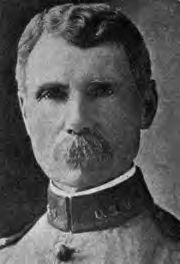Theodore Schwan facts for kids
Quick facts for kids
Theodore Schwan
|
|
|---|---|

Medal of Honor recipient
|
|
| Born | July 9, 1841 Bremerhaven, Germany |
| Died | May 27, 1926 (aged 84) Washington, D.C., US |
| Place of burial | |
| Allegiance | |
| Service/ |
Union Army |
| Years of service | 1857–1901 |
| Rank | |
| Unit | 10th U.S. Infantry 11th U.S. Infantry |
| Battles/wars | American Civil War Philippine–American War |
| Awards | Medal of Honor |
Theodore Schwan (born July 9, 1841 – died May 27, 1926) was a brave officer in the Union Army during the American Civil War. He earned the highest military award, the Medal of Honor, for his actions at the Battle of Peebles' Farm. He also served with honor in the Spanish–American War and the Philippine–American War.
Contents
Early Life and Civil War Service
Theodore Schwan was born in Wulsdorf, Germany, in 1841. This area is now part of Bremerhaven. He moved to the United States in 1857 when he was 15 years old.
Just before his 16th birthday, in June 1857, Schwan joined the U.S. Army as a Private. He served in the 10th U.S. Infantry.
When the American Civil War began, he continued to serve. He rose through the ranks from Private to Quartermaster Sergeant. In October 1863, he became a Second Lieutenant. He was promoted to First Lieutenant in April 1864.
Schwan received the Medal of Honor for his bravery in October 1864. During the Battle of Peebles's Farm, he saved a wounded Union officer. He dragged the officer to safety, stopping him from being captured by the enemy.
After the Civil War
After the Civil War ended, Theodore Schwan stayed in the Regular Army. He was promoted to captain in March 1866. He commanded a company and worked as a chief quartermaster in Minnesota.
He later served in various locations in Texas until December 1869.
Indian Wars Service
In December 1869, Captain Schwan was assigned to the Eleventh U.S. Infantry regiment. He served on the frontier at Fort Griffin and Fort Phantom Hill in Texas.
During the Red River War (1874-1876), he commanded Company G. In February 1874, his unit attacked a camp of Comanches in Texas. They killed eleven Native Americans and captured many horses.
In 1876, Captain Schwan and the Eleventh Infantry were sent to the Department of Dakota. They helped in the Great Sioux War of 1876-77 in the Dakota Territory and Montana. He served at several forts, including Fort Bennett and Fort Custer.
In 1877, Captain Schwan helped with a special mission. He accompanied Colonel Michael V. Sheridan to retrieve the bodies of officers who died in the Custer fight.
He also served as an Indian agent at the Cheyenne Agency in Dakota Territory in 1878. He helped create an Indian police force there. Later, he became an instructor at the School of Application for Cavalry and Infantry at Fort Leavenworth, Kansas.
Promotions and Leadership Roles
Theodore Schwan continued to advance in his career. In 1886, he became an assistant adjutant general with the rank of major. An adjutant general helps manage the army's records and administration.
He was promoted to lieutenant colonel in 1895. In 1898, he became a colonel and assistant adjutant-general. Just before this, he was also made a brigadier-general of volunteers.
Spanish–American War Role
When the Spanish–American War started, Schwan was appointed brigadier general of volunteers. This made him one of the few foreign-born generals in the war.
He took command of a division in the Fourth Army Corps. Later, he was given command of the Independent Regular Brigade. This brigade sailed to Puerto Rico.
On July 31, 1898, his brigade landed at Guánica. They moved along the coast. On August 10, his brigade won the Battle of Silva Heights. The next day, they entered the town of Mayagüez, Puerto Rico. A cease-fire was called before more fighting could happen. It is said that during this time, Schwan's troops played the first game of baseball in Puerto Rico.
Philippine–American War Role
After the fighting in Puerto Rico, General Schwan was sent to the Philippines. He became the chief-of-staff for the Eighth Army Corps. This corps was involved in the Philippine–American War.
He led the first Cavite Expedition and later commanded the Second Brigade during the second Cavite Expedition.
Retirement and Legacy
Theodore Schwan retired from the army in 1901. He was given the rank of Major General of Regulars on the retired list. He passed away in 1926 and was laid to rest at Arlington National Cemetery.
See also


